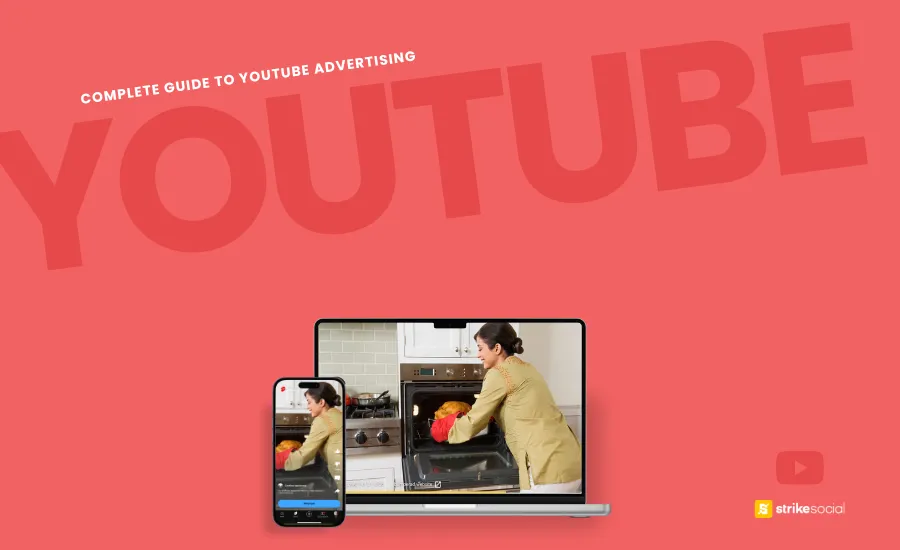Strike Overview
- As the most popular social media platform in the U.S., with 83% of users nationwide, if you haven’t started YouTube advertising yet, you should already have your campaigns ready before 2024 closes off.
- Both advertisers and consumers increasingly love YouTube ads more than other traditional TV ad formats, as confirmed by 59% of TV viewers and 43% of brands leaning toward YouTube Shorts advertising.
- With Strike Social’s YouTube ads guide, know how you can prepare for advertising on YouTube and its different ad placements to fully maximize its reach and engagement capabilities.
Jump to Section
The Beginner’s Guide to YouTube Ads
Aside from the usual video content, one thing that’s probably more common is the amount of YouTube ads you see. While they may seem interruptive to some viewers, these ads actually introduce audiences to your brand and can even encourage them to visit your website or watch your ads in full. With an average of 48 minutes spent daily by users on the YouTube app, there are multiple ways to reach them across various formats and ad types.
Learn the basics of YouTube advertising, from targeting strategies to optimization techniques, to see how this platform can help you get your brand out there.
YouTube Ads Explained
As part of the Google ecosystem, YouTube has more reach than ever, with ads appearing not only on the YouTube app but also on YouTube TV and across the Google Display Network (GDN).
If you’re familiar with YouTube ads at a surface level, we’ll guide you through every aspect of utilizing YouTube as an advertising platform for your business.
What Are YouTube Ads?
YouTube ads are video or animated ads that promote a brand through engaging content on YouTube and across Google’s Display Network. They can introduce audiences to your products, highlight services, or feature current promotions in a way that captures attention and drives action.
When done right, a well-crafted YouTube ad strategy can reach up to 11 million views, achieve 2,000 conversions, and deliver as much as 7x ROAS.
YouTube Advertising Formats, Specs, and Safe Zones
YouTube offers a variety of ad formats that help you reach audiences across different screens and contexts. Whether you want to make a quick impact or engage viewers with a longer story, here’s a breakdown of the main YouTube ad formats:
- In-stream ads
- YouTube in-stream ads play before, during, or after a YouTube video, often aligning with the viewer’s current video content or viewing habits.
- Types of in-stream ads on YouTube:
- Skippable In-Stream Ads
- Non-Skippable In-Stream Ads
- Bumper Ads
- In-feed ads
- When browsing through the app or related videos of the current video you are watching, YouTube in-feed ads are inserted as you scroll through. These may auto-play without sound as viewers scroll, encouraging them to stop and engage.
- Types of YouTube in-feed ads:
- YouTube app in-feed
- YouTube watch feed
- Masthead ads (by reservation only)
- YouTube Shorts ads
- Ads on YouTube Shorts appear in between videos as you scroll through the Shorts feed. For example, while enjoying a quick video on a new dance trend, an ad might pop up as you swipe to the next clip, offering a brief interlude before you continue browsing more Shorts content.
- Outstream ads
- Your ads can reach audiences beyond YouTube through “outstream” placements on Google Video Partners (GVP) and the Google Display Network (GDN). These ads are shown on both mobile devices and desktops, allowing you to engage viewers who may not be actively browsing the YouTube app.
- Other formats
- Mid-roll ads: Shown within videos longer than 8 minutes.
- Back-to-back ads/ad pods: Two consecutive ads shown before or during a video.
The YouTube ad specs vary based on your campaign objectives and chosen formats. Whether targeting placements within the YouTube app or looking to advertise on YouTube TV and Google TV, ads can appear in either 16:9 or 9:16 formats.
Here’s a quick overview of the essential YouTube ad video specs and technical requirements:
- File format: .MPG (MPEG-2 or MPEG-4), .WMV, .AVI, .MOV and .FLV .MPEG-1, .MP4, .MPEGPS, 3GPP, WebM, DNxHR, ProRes, CineForm & HEVC (h265)
- Preferred video codec: H.264, MPEG-2 or MPEG-4
- Preferred audio codec: MP3 or AAC
- Resolution:
- 1080p (Full HD)
- Recommended pixels (px) for HD: 1920 x 1080px (horizontal), 1080 x 1920px (vertical)
- 720p (Standard HD)
- Minimum px: 1280 x 720px (horizontal), 720 x 1280px (vertical)
- SD
- 640 x 480px (horizontal), 480 x 640px (vertical)
- 1080p (Full HD)
- Frame rate: 30 FPS
- Aspect ratio:
- Horizontal — 16:9 (HD), 4:3 (SD)
- Vertical — 9:16 (HD), 2:3 (SD)
- Maximum file size: 1GB to ≤256 GB
- Length: Best video length for YouTube ads is between 12 seconds to 3 minutes
- 6 seconds (YouTube bumper ads)
- <60 seconds (YouTube Shorts)
- 15-20 seconds (up to 30 seconds for YouTube TV ads) (non-skippable in-stream)
- No max length for in-feed and skippable YouTube ads
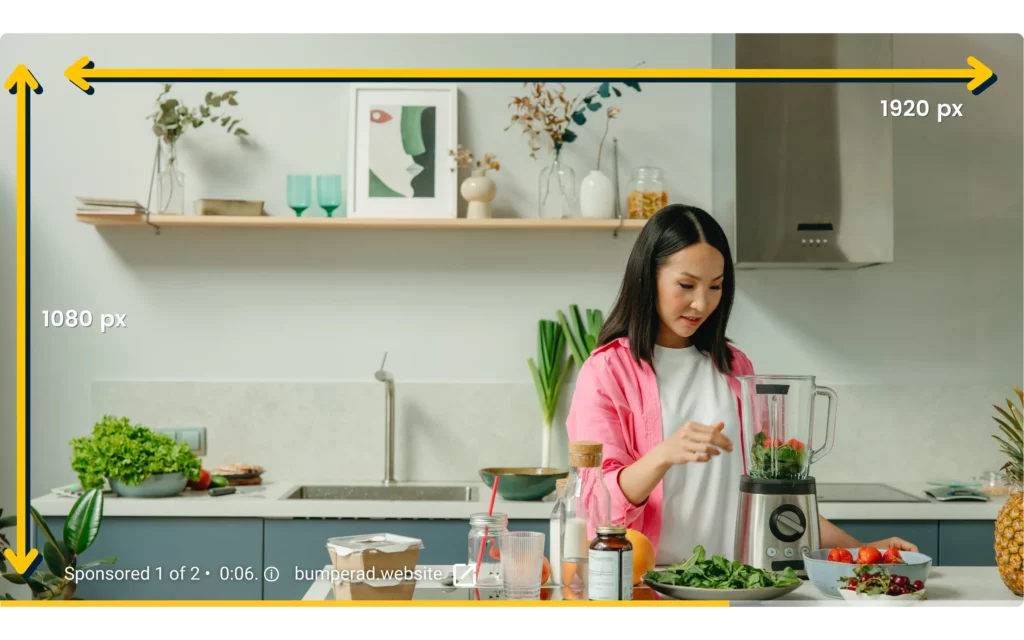
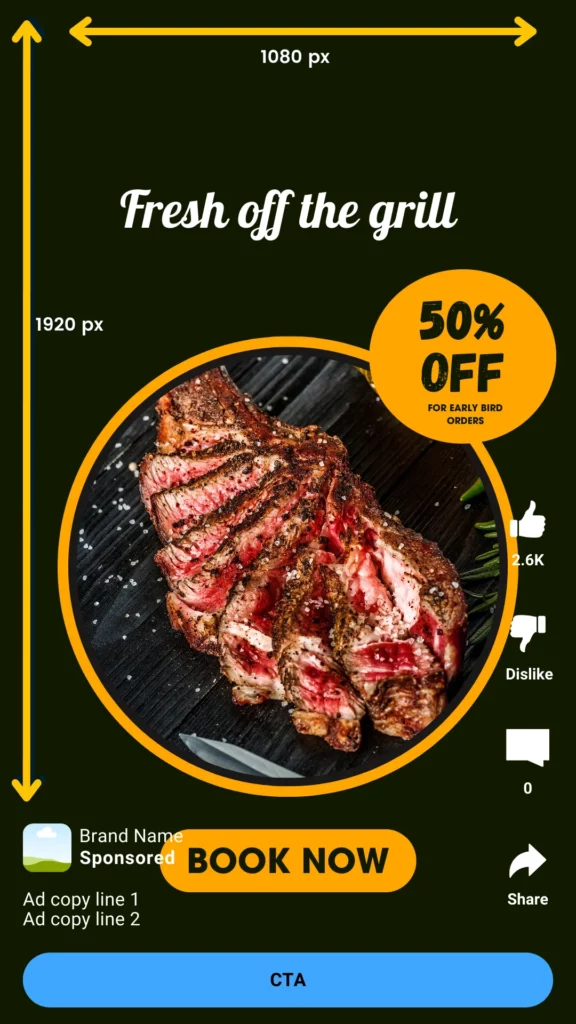
* For optimal quality, we recommend using HD resolutions whenever possible (vs. SD).
Further Reading
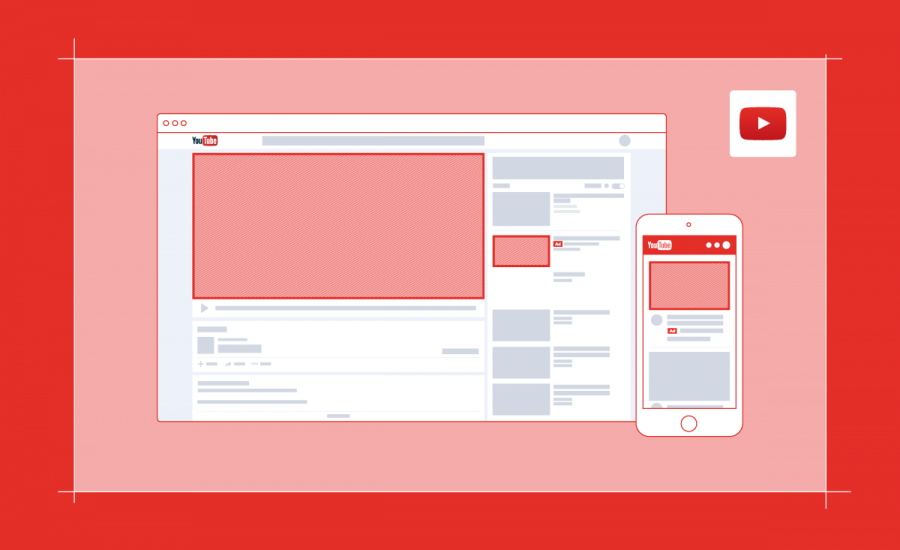
The Complete List of YouTube Ad Specs
If you’re looking for non-skippable YouTube ads specs, in-stream, or YouTube Shorts video requirements, you can find them all in this comprehensive blog. See the detailed requirements on video length, resolution, file format, and aspect ratios to ensure your ads meet YouTube’s guidelines.
When complying with the YouTube ad sizes, take note that your entire ad might not be fully visible. Both the YouTube app and YouTube TV interface feature elements like the Skip Ad button and engagement options (like, share), which can obscure portions of your video.
To help with this, we’ve created YouTube ad safe zone guides to show you where to avoid placing text or CTAs, ensuring your ad remains fully visible within the safe zone.



Further Reading

Safe Zone Guide for Vertical Video Ads
As a YouTube advertiser, the Shorts placement must already be on your radar. Don’t limit your vertical video ads to just one platform—find the optimal safe zones to promote across other short-form video platforms like TikTok and Instagram Reels.
Types of YouTube Advertising Campaigns
With a wide range of options for both organic and paid marketing on YouTube, it’s essential to choose the right type of paid ad campaign that aligns with your specific goals.
No matter your video advertising objective, there’s a YouTube ad campaign type designed to help you succeed—here’s a breakdown of your options:
Video Reach Campaigns (VRC)
- By its name, VRC is perfect for Awareness and Reach objectives. In addition to broad visibility across the YouTube app, VRC now also allows advertisers to extend their reach to Google TV and YouTube TV channels. Available YouTube ad formats for VRC include in-stream (bumper and skippable), in-feed, and Shorts.
- VRC campaign types:
- Efficient reach
- Non-skippable reach
- Target frequency
- With on-point creatives, precise targeting, and the right social media advertising agency, Strike Social’s 2024 data shows a 41% lower CPM for VRC than YouTube Trueview.
Further Reading
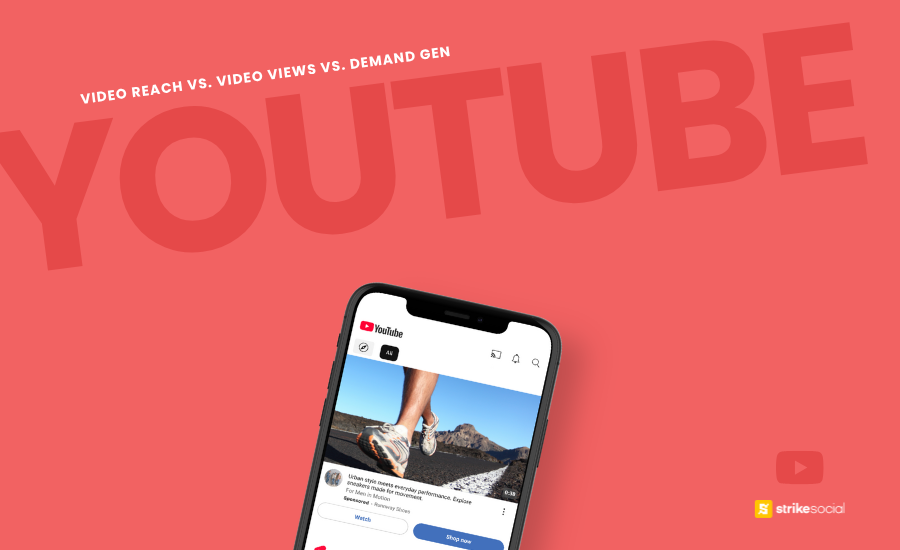
YouTube Campaigns Explained: Video Reach, Video Views, and Demand Gen
While each campaign type supports a different stage of the funnel, their full potential often extends beyond just awareness or conversions. Learn how to align each format with your broader campaign goals.
Video View Campaigns (VVC)
- Designed to maximize views, Video View Campaigns uses Google’s AI to strategically place YouTube ads where they are most likely to be watched and engaged. Placements include in-stream (skippable ads), in-feed, and YouTube Shorts feed.
- Since its launch in Q3 2023, VVC has shown significant cost efficiency, with our campaigns demonstrating up to 56% savings.
- For brands looking to tell their story through YouTube video advertising, our data on Video View Campaigns show great view-through rates (VTR), particularly on Connected TV and mobile devices, where audience engagement and viewer retention are highest.
Demand Gen (formerly Video Action Campaigns)
- Demand Gen campaigns help turn interest into action, whether it’s making a purchase with YouTube shopping ads, visiting your site, or signing up for a service.
- Previously known as Video Action Campaigns (VAC), this format now includes additional Google properties like Discover and Gmail, expanding your reach beyond YouTube.
- As of Q2 2025, the full transition to Demand Gen is complete, with early adopters seeing up to 40% lower CPC according to our latest YouTube benchmark report.
Further Reading
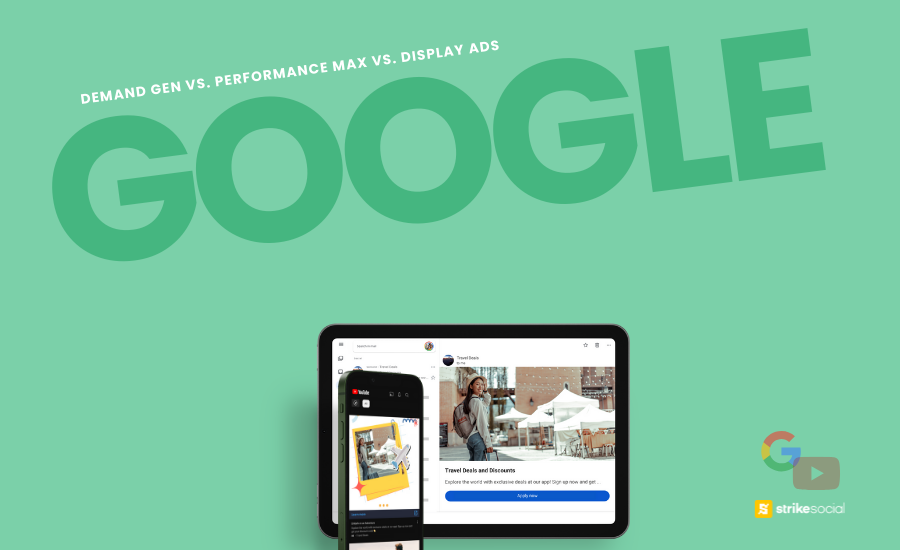
Demand Gen vs. Performance Max vs. Display Ads
While Demand Gen now spans from YouTube, Discover, and Gmail, its overlap with Performance Max raises a common question: how are these campaigns different, and where does Display fit in? Understand the distinct role each campaign type plays in your strategy and learn how to maximize their strengths effectively.
Performance Max
- Another way to promote through YouTube ads and expand across the Google Search Network, Gmail, Display Network, and Discover channels is to use Performance Max campaigns (commonly known as PMax).
- Previously, Google PMax ads have caused some turmoil with brand safety and ad suitability due to appearing on unauthorized websites and YouTube Kids videos. It takes scrutiny and making sure ad placements are visible to make sure you are fully aware of when and where your PMax campaigns show up.
- Since then, significant improvements have been made to enhance transparency for YouTube advertisers. During the Google Marketing Live 2024 announcements, it was announced that YouTube placements and exclusions will now be visible to brands running Performance Max campaigns.
- Moreover, YouTube’s parent company, Alphabet, has been enhancing the AI capabilities of PMax ads. This includes innovations such as a text-to-image model for creative assets and ‘page-specific assets’ that help better align ads with placement websites and improve engagement with audiences.
YouTube Ad Placements
When advertising on YouTube, you can be seen on more than just the mobile app or the website itself. Your YouTube video ads can conquer everything from small smartphones to bigger Connected TV screens.
Here in our YouTube ads guide, we show you the platforms and placements available for your YouTube campaigns:
- YouTube app: Users can download the YouTube app from their smartphones, tablets, or desktop devices. The same ad placements when users visit the YouTube website across their devices.
- Connected TV: Yes, your YouTube paid ads can also appear on TV! Through Connected TV advertising, you can tap into an audience of over 300 million monthly users. CTV ads have proven highly effective, with some campaigns achieving up to 65% video ad completion, even with skippable ads.
- YouTube TV: YouTube TV is a subscription-based service that provides live television channels and content such as shows, sports, and events. It currently boasts over 8 million subscribers and continues to grow. Yet another way to reach audiences on YouTube TV is through Pause Ads, which allows your ads to appear on viewers’ screens while they pause content.
- Google TV: Similar to YouTube TV, Google TV is also a streaming platform accessible through devices like Chromecast, smart TVs, mobile devices, or the new Google TV Streamer. As of September 2024, Google TV’s network already offers 150 channels, with more to come.
- Google video partners (GVP): Google video partners are trusted, high-quality websites and apps where your YouTube ads can be displayed outside of the YouTube platform. Partnering with Google has advantages, as YouTube can use Google’s inventory to get more video views and impressions even when the intended audience is not using YouTube itself.
What You Need to Know Before Launching Your YouTube Ad Campaigns
As we move forward in this YouTube advertising guide, it may seem that running ads on YouTube sounds easy. But before anything else, you must iron out your YouTube ad strategy before going to Ads Manager to start running your campaigns.
Audience Targeting
YouTube ad targeting can take many forms: device, location, gender, age, interests, etc. There are two primary audience segments within Google Ads where you can define your target audience for YouTube campaigns:
- Audience: Targeting the who, when, where, and what—gender, age, parental status, household income*, interests, locations
- In simpler terms, YouTube audience targeting is simply targeting your target market. With a potential audience base of 238 million unique users in the US, the key here is being specific about who you want your YouTube ads to be viewed by.
- For instance, an HVAC brand trying to take advantage of the demographic’s interest in sports using YouTube Custom Intent audiences can effectively acquire 11 million views through its campaign despite being a non-sports-related brand.
*Targeting by household income (HHI) is only available in Australia, Brazil, Hong Kong, India, Indonesia, Japan, Mexico, New Zealand, Singapore, South Korea, Thailand, United States.
- Content: Targeting the YouTube content your audiences are engaged with—keywords and topics they are searching for, devices and platforms they are browsing or seeing content on
- YouTube contextual targeting allows your video ads to appear on your chosen relevant content so it blends better with the user’s viewing experience.
- For example, during a holiday advertising campaign, retail brands can target shoppers looking for product reviews. YouTube is the top social media platform for researching holiday purchases, and 76% of shoppers say product review videos help them make better purchases. Contextual ad targeting is the way to go to make sure you get into audiences’ YouTube screens.
- In this example, a gaming brand can select these options under Topics so their YouTube ads can appear within these contexts and related videos:
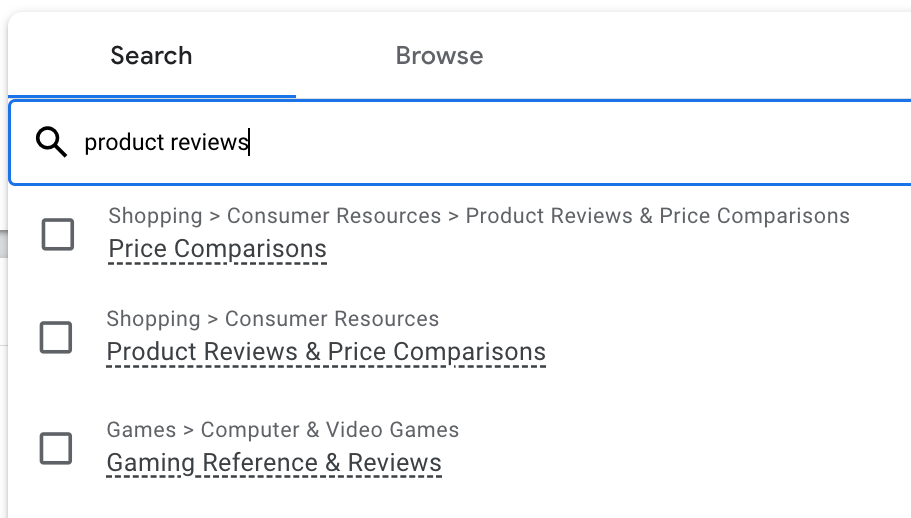
The key is refining the scope of your audience to ensure you are paying for impressions and views from engaged audiences only, but not so narrowly that you inflate costs or harm campaign performance.
To find out how you can analyze and take advantage of each YouTube ad targeting method, here’s a quick guide:
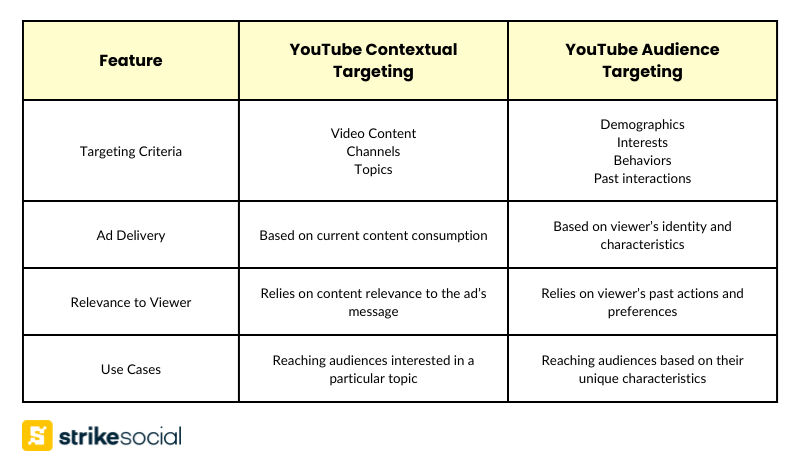
Optimizing YouTube Ads Cost
YouTube advertising costs will vary based on numerous factors, but the hard part is ensuring you’re only paying for engaged views while keeping your budget under control.
How to optimize the cost of ads on YouTube?
- Know the prevailing YouTube ad costs by industry
- According to our Q3 YouTube Ad Benchmarks Report, costs in industries such as finance and travel have been 13% and 9% lower than in Q3 2023, despite the busy holiday season and the U.S. elections.
- Continuous monitoring and optimizations
- Launching your YouTube video ads is not a one-and-done process. It needs to be checked constantly to ensure that your ads are delivering and that costs are not going over.
- For video reach or awareness campaigns, keep CPM costs in check. For campaigns with Views objectives, watch CPV and YouTube ad view rates closely.
- Utilize optimal creatives and YouTube ad placements
- As YouTube evolved with its advertising enhancements, advertisers must adapt as well. Skippable YouTube ads leveraging on reach are doing really well on Connected TV placements, outperforming mobile and other devices by 10-20% based on our 2024 Q1 report.
- Depending on the cost and performance of your YouTube ads during your campaign flight, study the data for the best insights to make an informed decision on how you can lean on better costs by utilizing your outperforming creatives and placements.
Performance and Cost Benchmarks
Along with setting your goals for what you want to achieve with your YouTube ads, such as views or conversions, you should set a criterion for the range to which you want your campaign results to match or even exceed.
Using our successful campaigns on YouTube advertising, here are the key YouTube ad metrics to set your sights on:
- YouTube ad cost benchmarks
- Cost Per Mille (CPM): $5.70 to $12.36 ¹; $2.87 to $8.02 ⁴
- CPM for CTV Skippable Ads: $7.39 to $10.01 ⁵
- CPM for CTV Non-Skippable Ads: $4.74 to $7.09 ⁵
- Cost Per View (CPV): $0.01 to $0.03 ²
- CPM for CTV Skippable Ads: $0.0128 to $0.0220 ⁵
- Cost Per Click (CPC): $0.34 and $1.42 ³
- Cost Per Mille (CPM): $5.70 to $12.36 ¹; $2.87 to $8.02 ⁴
- YouTube ad views and performance benchmarks
- Click-through Rate (CTR): 0.07% to 0.17% ¹; 0.11% to 1.22% ³; 0.01% to 0.11% ⁴
- View Rate (VR): 43% to 57% ²
¹ Based on 2023 US YouTube TrueView InStream Non-skippable Campaigns
² Based on 2023 US YouTube TrueView InStream Skippable Campaigns
³ Based on 2023 US Video Action Campaigns
⁴ Based on 2023 US YouTube Bumper Ads
⁵ Based on Connected TV ad rates, 2024 US YouTube TrueView Ads Campaigns
Brand Safety and Suitability in YouTube Advertising
Even major brands with YouTube video ads can be criticized if they are displayed with inappropriate, unsuitable content that gives the brand a negative perspective. Thus, ad suitability and brand safety on YouTube are key to making sure your ads are shown with related content and away from the explicit content that may be lurking within the platform.
What brand safety features does YouTube have?
- YouTube inventory types: Choose from expanded, standard, or limited inventory. The recommended setting is “Standard”. “Expanded” extends your reach across more inventory, while “Limited” ensures your ads avoid more suggestive or explicit content.
- Third-party brand safety technology: With the help of carefully vetted third-party providers, YouTube continues to develop brand safety measures to maintain integrity in impressions and views generated through YouTube ads. These providers include Integral Ad Science, DoubleVerify, VuePlanner, and more.
How to ensure YouTube ad suitability with my campaigns?
- The difference between brand safety and brand suitability is that the latter focuses more on aligning your brand values with your target audience to strengthen the connection. Brand safety starts the process, and ad suitability fortifies it.
- YouTube has developed many tools for content suitability, which include the following:
- One key concern is appearing on YouTube Kids videos, as these are primarily viewed by children who do not have purchasing power. This means that clicks or views from these videos do not contribute to YouTube ads’ ROI. Ad suitability is achieved by excluding Kids channel placements and reallocating these views to more relevant audiences who can make a purchase or remember your ad for future decisions.
Step-by-step Guide to Publishing Your YouTube Campaign
Feel like you have everything you need and are ready to start video advertising on YouTube? Here are the basic steps to follow:
1. Set up your Google Ads account. You can use your existing Gmail account or use your business account. If you need to add access for your social media advertising manager or media buyer, you can do so by adding and editing Google Ads users to allow your team to help you manage your ads.
2. If you do not have one yet, create a YouTube channel for your brand and upload the video ad you will be using for your campaign. You’ll need the YouTube link to your video to add it to your campaign later.
3. Link your YouTube channel to your Google Ads account. Aside from performance tracking, this also allows Google Ads to acquire data for remarketing on YouTube for future video ad campaigns.
4. Once your Google Ads account is set up, go to the overview dashboard and click ‘+ New campaign.’
5. Choose your campaign objective, type, and subtype. For some scenarios, there will be another subtype before proceeding to the next screen. For example:
- Objective: Awareness and consideration
- Campaign type: Video
- Campaign subtype: Video views (click Continue); Video reach (select VRC subtype – e.g. Target frequency, then click Continue)
6. Fill in the rest of the campaign information, such as the name, budget, and start and end dates. Arrange your audience targeting settings as desired. As you update your campaign settings, ad formats, exclusions, and other elements, you can find an audience estimate on the right side of your screen.
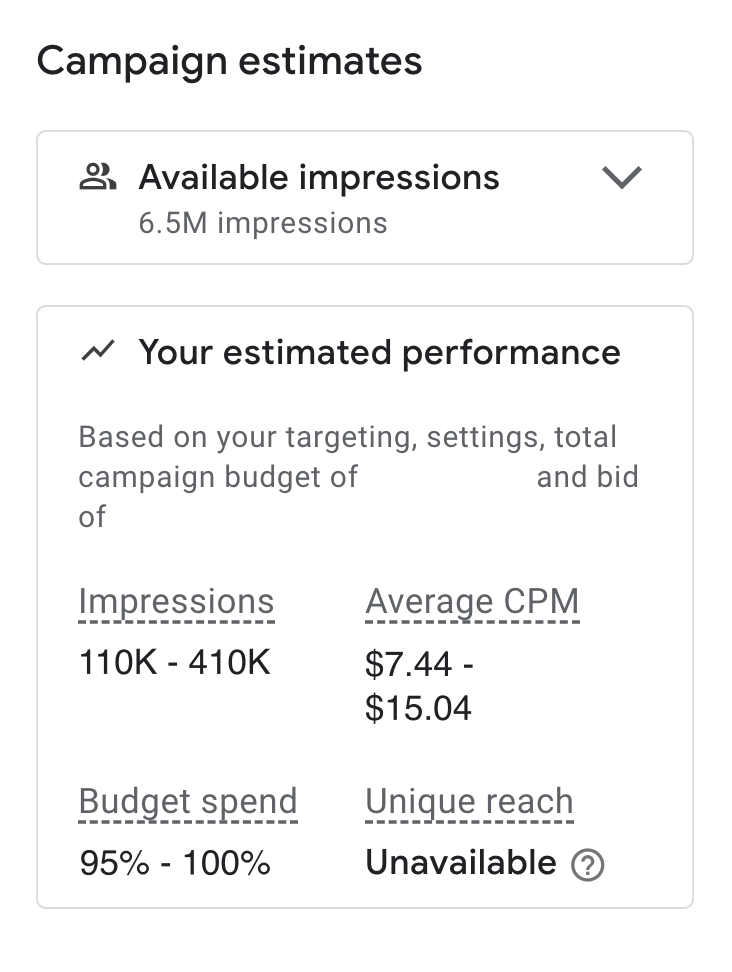
7. Set up your video ads. Paste the YouTube URL so it retrieves the video from the platform. Add your target URL, CTA, ad headline, and description. You can add more creatives as desired and set them up using the same process, abiding by the YouTube ad copy specs.
8. Finally, set up your bid strategy. For an awareness campaign, the target CPM bid is the amount you are willing to pay for each 1000 impressions, which will be your entry in the ad auction.
9. Review your campaign setup. Once done, click on Create campaign.
Most YouTube ad campaigns are reviewed within 1 business day. Once your ad is approved (or rejected), you should receive a notification via Google Ads or your Gmail account.
Do You Need a YouTube Advertising Agency for Better Results in 2025?
After publishing your YouTube video ads, the real work starts during the monitoring and adjustments phase. Your social media advertising team must monitor cost levels, bid adjustments, and ad performance to ensure the best possible results.
This is a full-time endeavor that requires a dedicated team. If you think your YouTube ads strategy may be too heavy for your in-house team, consider hiring a YouTube advertising agency.
Benefits of Partnering with a YouTube Ads Agency
- Reduced In-House Workload
- YouTube advertising, particularly YouTube TV, requires significant resources. An agency can help by managing large-scale campaigns, freeing up your in-house team to focus on other platforms that require less effort.
- YouTube TV advertising, in particular, may be new to teams accustomed to traditional social media ads, making agency expertise invaluable for optimizing Connected TV placements and providing round-the-clock monitoring.
- Knowledge of Prevailing Costs and Performance
- A YouTube marketing agency continuously analyzes campaign performance data and industry benchmarks, always aiming for better results.
- Access to Advanced AdTech Solutions
- Our proprietary AI tool, Campaign Lab, utilizes more than 13 years of machine learning to help us with YouTube advertising campaigns from start to finish. It also performs its own monitoring and checks, alerting our teams to optimization opportunities across running YouTube ad campaigns.
- Proven Experience with Client Success Stories
- Having worked with various brands across multiple industries gives a YouTube ads agency a broad perspective on what strategies work best for different audiences and objectives. From a portfolio of successful campaigns, here’s a handful of our successful YouTube campaigns with exceptional results:
Achieve Greater YouTube Ad Results This 2025
Video advertising is rapidly growing, and YouTube continues to outpace other streaming and TV services, becoming an even more powerful platform for reaching your target audience. It’s the perfect time to capitalize on this opportunity and make the most of YouTube’s inventory and reach.
Start planning your YouTube ads strategy for 2025. Contact us today for a personalized walkthrough and start driving better results with your YouTube campaigns.


